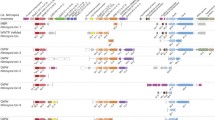Abstract.
The heterotrophic nitrifier Pseudomonas putida aerobically oxidized ammonia to hydroxylamine, nitrite, and nitrate. Product formation was accompanied by a small but significant release of NO, whereas N2O evolution could not be detected under the assay conditions employed. The isolate reduced nitrate to nitrite and partially further to NO under anaerobic conditions. Aerobically grown cells utilized γ-aminobutyrate as a carbon source and as a N-source by ammonification. The physiological experiments, in particular the inhibition pattern by C2H2, indicated that P. putida expressed an ammonia monooxigenase. DNA-hybridization with an amoA gene probe coding for the smaller subunit of the ammonia monooxigenase of Nitrosomonas europaea allowed us to identify, to clone, and to sequence a region with an open reading frame showing distinct sequence similarities to the amoA gene of autotrophic ammonia oxidizers.
Similar content being viewed by others
Author information
Authors and Affiliations
Additional information
Received: 9 April 1998 / Accepted: 15 May 1998
Rights and permissions
About this article
Cite this article
Daum, M., Zimmer, W., Papen, H. et al. Physiological and Molecular Biological Characterization of Ammonia Oxidation of the Heterotrophic Nitrifier Pseudomonas putida . Curr Microbiol 37, 281–288 (1998). https://doi.org/10.1007/s002849900379
Issue Date:
DOI: https://doi.org/10.1007/s002849900379




